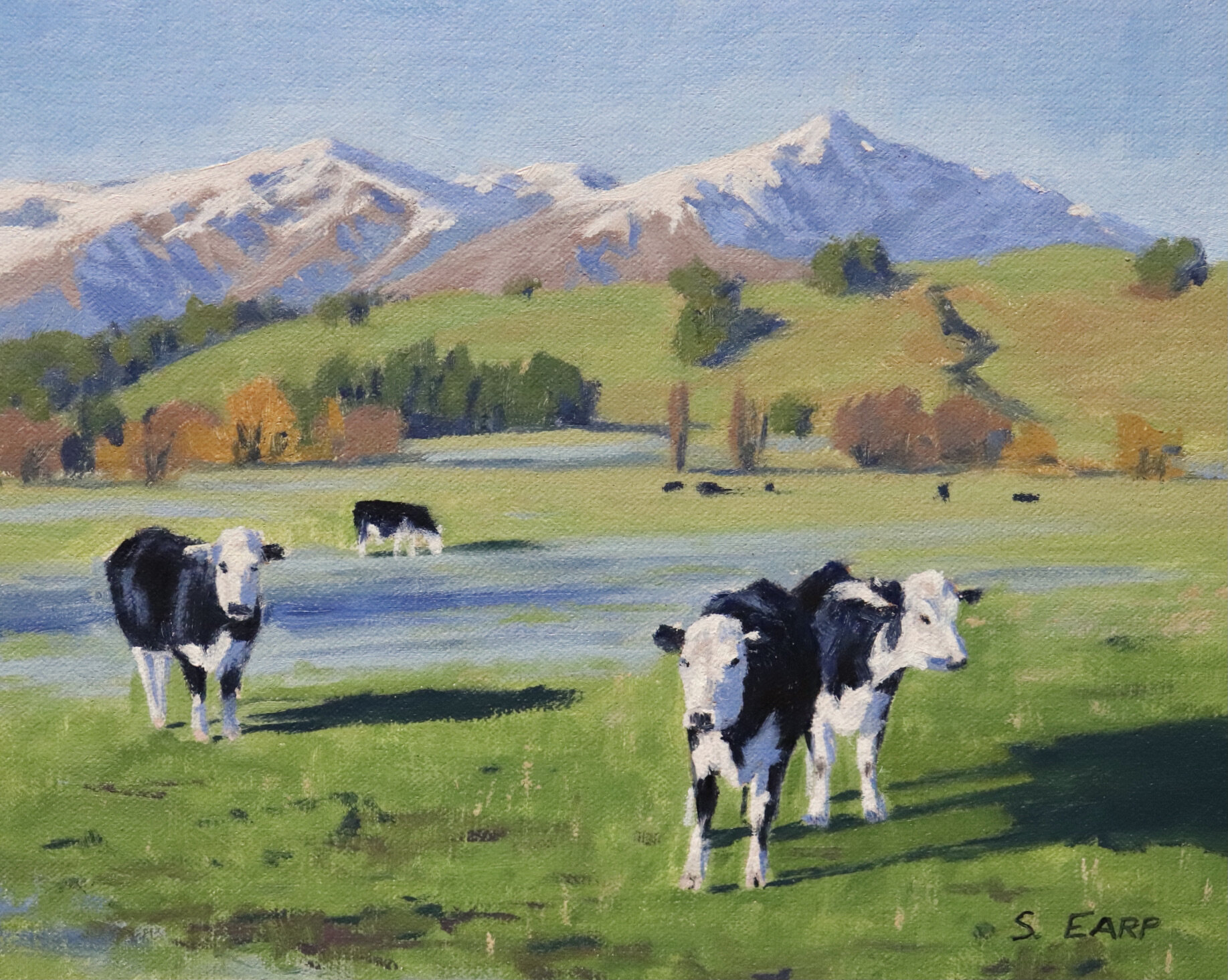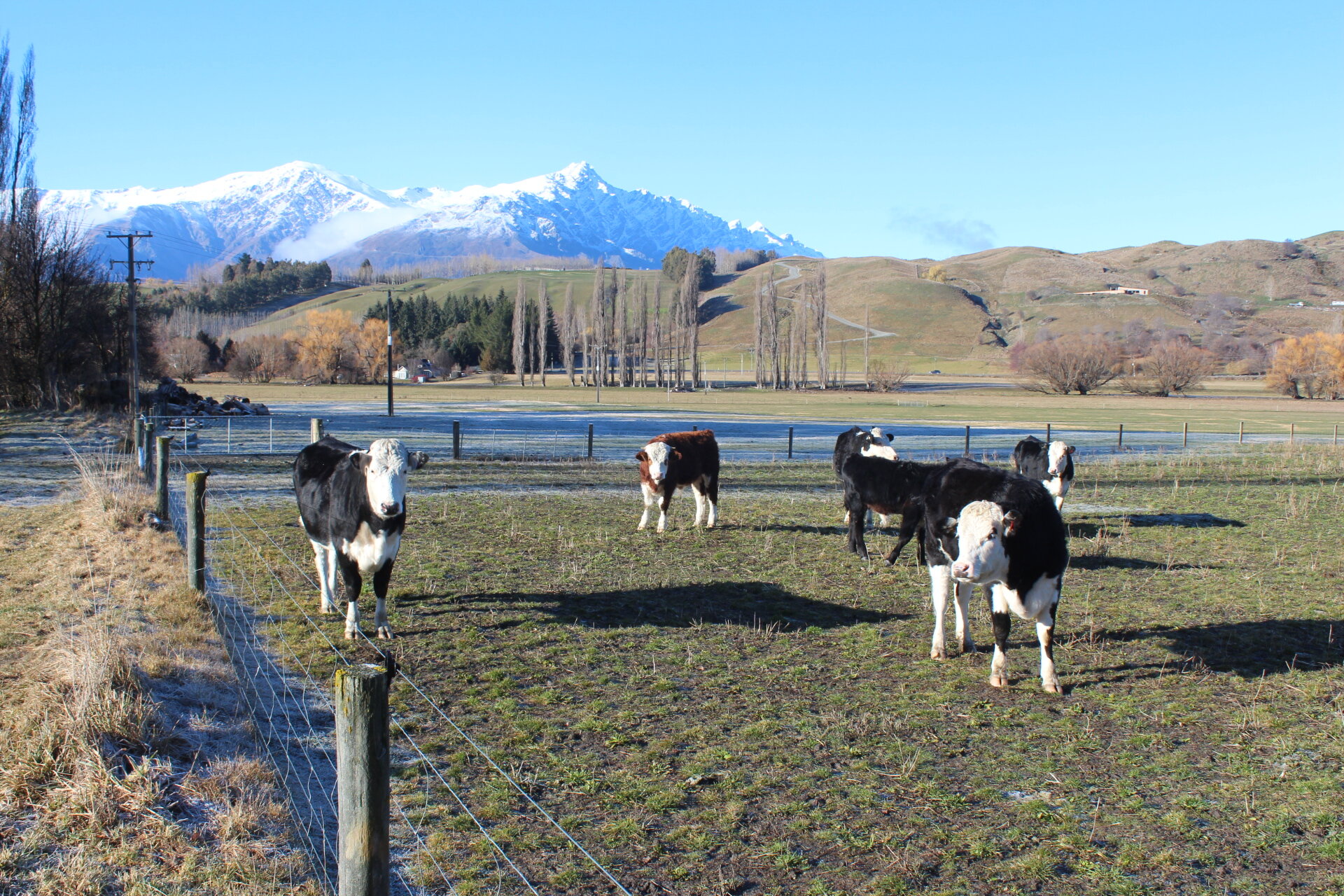
In this written painting tutorial, I will show you how to paint this frosty winter rural landscape that features cows in a field. Including animals in landscape paintings adds life and atmosphere to an image. Even just the suggestion of a few animals in the distance can make your painting look alive.
The Queenstown area inspires this painting in the south island of New Zealand.
Reference Photos
Here are some reference photos I took and used in this painting. Please feel free to use or copy these photos if you would like to have a go at painting this artwork.


Colours
I painted this artwork using oil paint and the colours I used in this painting are as follows:
- Titanium white
- Burnt sienna
- Yellow oxide (you can also use yellow ochre instead)
- Cadmium yellow
- Cadmium orange
- Quinacridone crimson (you can also use alizarin crimson instead)
- Ultramarine blue
- Phthalo green
Brushes
Here is a list of the brushes I used in this painting:
- No.5 flat
- No.3 flat
- No.2 flat
- No.3 filbert
- No.0 round
Painting Demonstration
I am painting on an 8” x 10” linen panel. The panel is pre-made with a medium weave linen that is oil primed. These panels are perfect for creating small artworks and studies and are also great for painting en plein air.
I sketched the composition using a No.1 round brush with burnt sienna mixed with Liquin Original (Liquin). I am using Liquin as a medium to thin the paint, which also speeds up the drying time.

I always begin my paintings by painting the dark values and shadows first. This helps to create a tonal dynamic in the image that I can work from, making it much easier to paint the areas in this landscape that are in the light.
What Are Values?
As landforms recede into the distance, shadows and dark areas become less valuable. Value refers to how light or dark a subject is. We will find our darkest darks and lightest lights in the foreground, but as landforms recede, darks are not as dark, and the sunlight is not as soft. Understanding this makes it much easier to create atmospheric depth in your paintings.
First of all, here I paint the mountain shadows using a mix of ultramarine blue, burnt sienna, titanium white and a little quinacridone crimson. The frost in the foreground is similar in value and colour, so I can use the same colour mix I used for the background mountains.
Next, I paint the shadows in the mid-ground trees darker than the mountain shadows. I can use the same colour mix as the mountain shadows, but I use less titanium white.
The cow’s fur is nearly black, so I mix ultramarine blue and burnt sienna. As burnt sienna is a dark orange combined with its colour opposite on the colour wheel, blue; it creates a near black.

Now that the dark values in the painting are established, I start painting the areas of the landscape that are in the light, beginning with the furthest zone away in the scene, which is the sky. The sky is a simple mix of ultramarine blue, titanium white and a small amount of phthalo green.
The slopes in the background mountains that are in the full sunlight are a pale earthy colour and is a mix of burnt sienna, ultramarine blue, quinacridone crimson and titanium white. I’m using more burnt sienna in my mix. Note how the colours I have used here are the same as the mountain shadows, except the burnt sienna is more dominant. I am conscious of using standard colours throughout my painting to create colour harmony.

Next, I start working on the grass in the mid-ground and foreground. The chroma or saturation of the grass will be lower in the mid-ground compared with the foreground. It is essential to desaturate the greens in the mid-ground hills a little bit so that the colours don’t jump forward in the painting.
I create a mix of yellow oxide, ultramarine blue, phthalo green and titanium white for the mid-ground hills. I also mix in a little quinacridone crimson for some of those pinkish areas within the grass. This helps to create interest and texture.
As I work forward in the painting and move towards the foreground, I use my existing green mix that I just made but I increase the saturation by adding cadmium yellow and a little more phthalo green. I round off the colour with a little cadmium orange.
Whenever I paint large masses or areas, I prefer to use larger brushes; in this case, I used a No.5 flat brush.

I paint the trees in the mid-ground field with yellow oxide, cadmium yellow, ultramarine blue and a little titanium white. I use more ultramarine blue in my green combinations here, as trees are some of the darkest values to be found in the landscape.
The shadows in the cow’s white fur are a mix of ultramarine blue, burnt sienna and titanium white. I begin marking these in with a No.2 flat brush.

I painted the areas of the cow’s white fur in the full sunlight with a mix of titanium white and burnt sienna. Once I have established the central zones and colours within the cow’s bodies, I then work the paint to get the proportions of the animals. In general, I still wish to maintain a looseness and fluidity to the cows so it is in keeping with the rest of the landscape.
I use the same white mix I used in the cows for the snow on the mountains.
I can paint around the hostile areas of the cows, and the grass to make further corrections to the cow’s proportions. I then start adding additional details to the cows, and it is here I am using smaller brushes, mainly No.2 flat brushes and No.0 round brushes.

I finish the painting by adding finer details to the cows. I also make sure the shadows cast by the cows line up with their hooves. The clouds in the grass mix ultramarine blue, yellow oxide and titanium white. The shadows are significant because they help to create the overall three-dimensional effect in the painting.
I add more texture to the grass and some areas of mud and dirt, a mix of burnt sienna, quinacridone crimson, ultramarine blue and titanium white.
I paint the snow on the shadow side of the mountains with a mix of ultramarine blue, quinacridone crimson and titanium white.
I add some final details, such as the suggestion of cows in the background.

Thank you for reading 😊